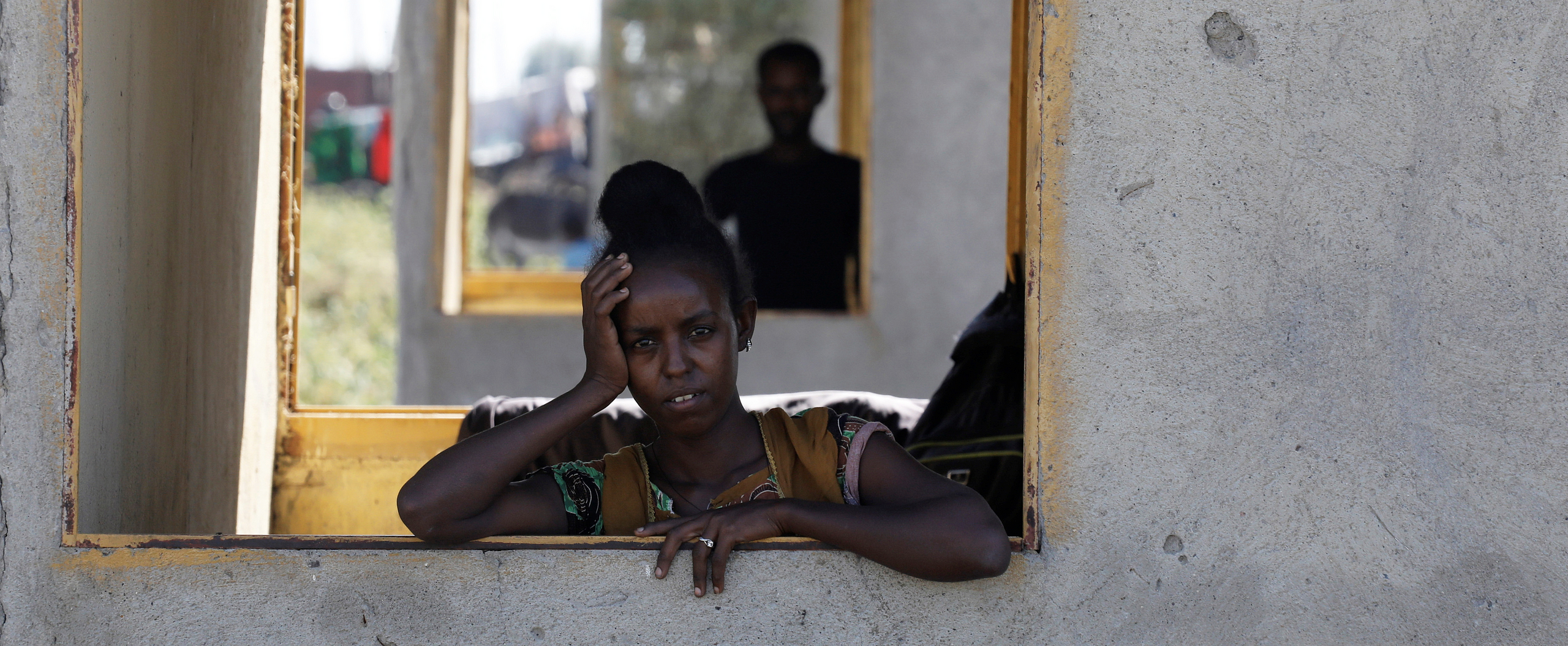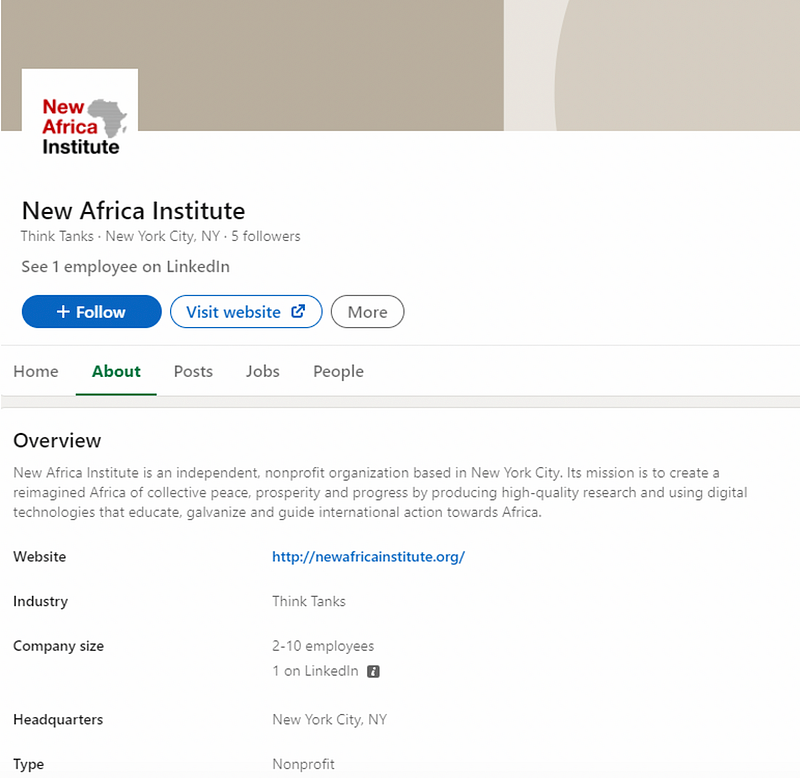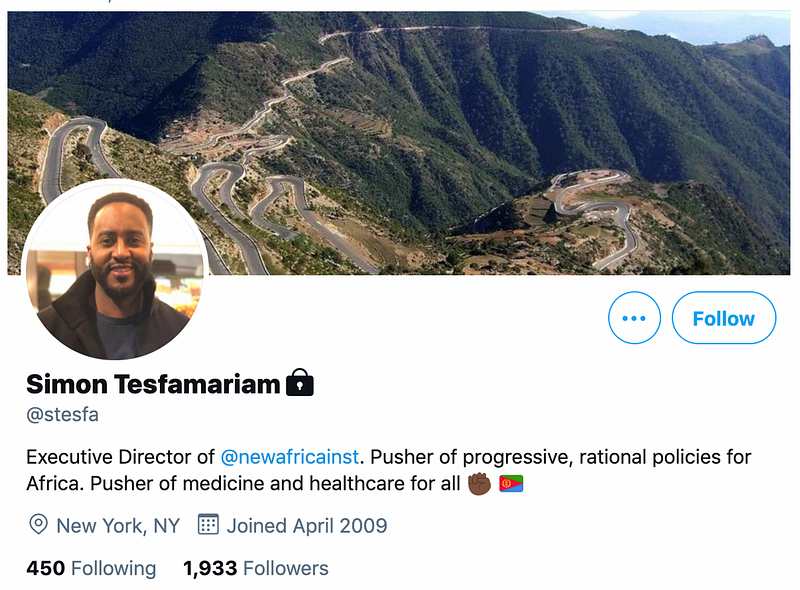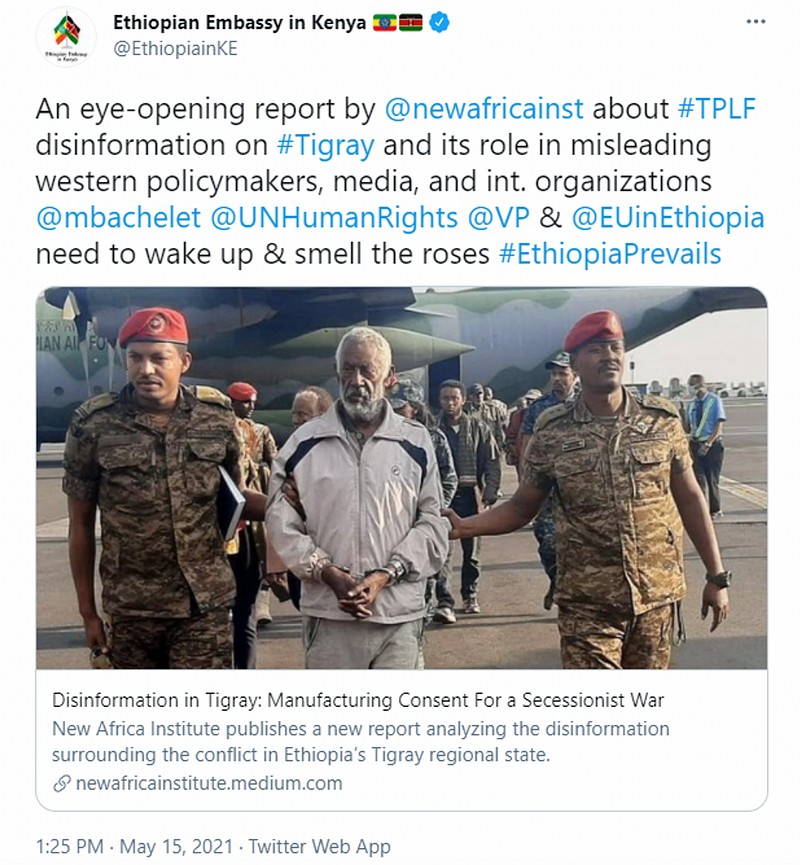Eritrean officials promoted a report undermining evidence of violence in Tigray, claiming an international disinfo campaign

On May 9, 2021, a report entitled “Disinformation in Tigray: Manufacturing Consent For a Secessionist War” was published to Medium by a group referring to itself as the New Africa Institute. Claims that the report was endorsed by Eritrean government officials have cropped up online, and the document itself has been amplified by Ethiopian embassies, ministers, and celebrities alike.
The 72-page report accuses Western media of being complicit in spreading disinformation about the crisis in Tigray, Ethiopia, and Eritrea’s involvement in the ongoing conflict. Fighting broke out on November 4, 2020, after the Tigray People’s Liberation Front (TPLF), the region’s ruling party, attacked a federal military base. Ethiopian Prime Minister Abiy Ahmed subsequently sent troops into the northern province after declaring a “military confrontation.”
Hostilities between Eritrea and neighboring Ethiopia, governed by a TPLF-dominated government, raged for decades until Ahmed was appointed Ethiopia’s Prime Minister in 2018 and a peace deal was signed by the two countries. Eritrea is often described as having one of the most repressive regimes in the world. According to BBC the country is the only African country without privately owned media, after it banned independent media in 2001. In 2021 Reporters Without Borders ranked Eritrea the most censored country in the world.
Throughout the conflict, both the Ethiopian and Eritrean governments claimed that Western media outlets were spreading disinformation and propaganda supportive of the TPLF. In February, Mulubirhan Haile, the Ethiopian government Deputy Administrator of Tigray, told government news agency ENA that disinformation spread on social media, such as claims that Eritrean forces were in Tigray, “does not reflect the truth on the ground as there is currently a peaceful movement in Tigray Regional State.”
Despite international rights groups accusing Eritrean soldiers of committing atrocities in Tigray, Ahmed and Eritrean President Isaias Afwerki denied Eritrea’s presence in the conflict-ridden region. In December 2020, Eritrean Foreign Minister Osman Saleh Mohammed decried allegations of Eritrean soldiers’ presence in Ethiopia as “propaganda,” explicitly telling The Guardian the country was not involved in the conflict.
However, almost five months after fighting broke out in the region, Ahmed did an about-turn and claimed the Eritrean government had done Ethiopia a “lasting favor” by entering the conflict.
Content of the report
In the announcement of the publication, The New Africa Institute wrote on its previously unused Medium page:
Since the start of hostilities, there has been an explosion of disinformation in the mainstream and social media. This report carefully analyzes the causes and methods of disinformation propagation. Ultimately, the disinformation serves to manufacture consent for an unpopular irredentist, ethnic secessionist war that could not be justified in the eyes of the international public through honest reporting.
The media, non-governmental organizations and Western governments have forwarded a number of allegations of crimes upon the people of Tigray perpetrated by the Ethiopian and Eritrean militaries. Eritrea has served as the primary scapegoat. Much of the reporting of these crimes, devoid of evidence and context, has proven sensational and racist with savage-like portrayals of Eritreans and Ethiopians that draw on old colonial tropes of Africans. This report looks beyond the gaudy headlines and provides sober, evidence-based analysis of the major allegations. Significant focus is given to social media as most disinformation about Tigray originates there.
The report’s conclusions summarized the primary focus of the 72-page document: a “TPLF disinformation network,” allegedly comprising Western journalists and governments, worked to scapegoat Eritrea and deceive the international community by promoting pro-TPLF propaganda. It uses terms like “disinformation” prominently, including in the title, to give it an air of authority and fact-checking rigor, despite being a work of political propaganda.
One of the main arguments presented by the report’s author, Simon Tesfamariam, is that displaced residents fleeing the conflict should not be trusted as reliable sources. In response to early reports about the military occupation as Ethiopian troops moved into Tigray, the report questions why journalists relied on “anonymous hearsay” rather than video and photo evidence, while also acknowledging that a communications blackout was in place, making it difficult to connect with people in the region to acquire evidence. This is not the first time he has stated that claims by witnesses, anonymized to protect their identity, should not be trusted. In a 2016 Voice of America article, he criticized the United Nations’ lack of video and audio evidence to support claims of abuse and said they had no “tangible evidence” to back up claims of abuse. He is quoted as saying, “Who would take seriously 100% anonymized allegations.” Notably, this same technique has been employed by the Ethiopian government: under the auspices of their “Emergency Fact Check” Twitter account, they cautioned the media against using eyewitness accounts because fleeing refugees may have been “infiltrated” by TPLF operatives.
We have received credible intelligence that TPLF operatives have infiltrated refugees fleeing into Sudan to carry out missions of disinformation. We caution media entities & international organizations to thoroughly investigate & verify information they receive.
— Ethiopia Current Issues Fact Check (@ETFactCheck) November 24, 2020
Simon Tesfamariam’s claims about Eritrea’s presence in Tigray also changed from sentence to sentence. On page 15 he wrote, “Eritrea’s government, though cagey on the matter, never officially denied a troop presence in Ethiopia.” Yet on the previous page, Tesfamariam quoted Eritrean Foreign Minister Osman Saleh Mohammed, who told Reuters that Eritrea was “not part of the conflict.”
One of the most egregious aspects of the report is its dismissal of claims about sexual violence committed by Eritrean forces against the women of Tigray. Eritrean soldiers have been accused of using sexual violence as a weapon against citizens of Tigray on multiple occasions. In Eritrea, women conscripted into the country’s mandatory national service are often subjected to what has been described as “rampant” sexual abuse, as well as forced domesticity. Yet according to the New Africa Institute, gang rape is “virtually unheard of in Eritrea.” Tesfamariam provides no evidence for this claim whatsoever.
Sweeping statements, such as the claim that gang rape is virtually unheard of or that refugees cannot be trusted, are presented throughout the report, which is filled with footnotes and additional information about the history of Eritrea and Ethiopia to add legitimacy to the entire piece, much of it not constituting additional evidence of the “disinformation” conspiracy they claim is taking place.
The New Africa Institute
Outside of Twitter, Medium and LinkedIn, the New Africa Institute (NAI), publisher of the report, has no online footprint. A LinkedIn page dedicated to them claimed the institute was a non-profit think tank and listed a New York City address as the Institute’s primary location.

The address was previously occupied by a non-profit coworking space called the Centre for Social Innovation (CSI). According to Simon Tesfamariam, the New Africa Institute was briefly a CSI member and rented a workspace in their New York City offices. However, the New York CSI offices had closed down months before the report was released. The DFRLab reached out to CSI multiple times to confirm whether NAI utilized their office space but received no response from the organization. However freelance Abraham Zere confirmed on Twitter that the New Africa Institute had briefly used the space two years prior to the report being published, and Tesfamariam told the DFRLab that NAI did use the space.
Though the LinkedIn page contains a link to a website, newafricainstitute.org was not a registered domain at time of publishing. A Google search for a website dedicated to NAI did not return any results, and the institute’s Medium and Twitter pages also did not contain links to a website.
Although the Twitter account @newafricainst was created in September 2014, the account’s oldest tweet is dated July 5, 2017, suggesting either that previous tweets had been deleted, or the account had been dormant prior to 2017. The account posted three times in 2017 — all three tweets linked to articles by NAI with the same New York address — before going dark for four years. There appeared to be no evidence of the New Africa Institute having an active digital presence between 2017 and 2021 until the publication of the “Disinformation in Tigray” report.
With regard the institute’s status as a nonprofit, the DFRLab could not find any evidence of a New Africa Institute registered as a 501c3 nonprofit entity in New York or anywhere else in the U.S. In a conversation with the DFRLab, Tesfamariam claimed the institute was in the process of registering as a nonprofit.
Simon Tesfamariam
While the LinkedIn page for the New Africa Institute claims it has between 2–10 employees, the DFRLab could only identify one person who worked for the institute: Simon Tesfamariam, a research medical doctor at Duke University. His Twitter bio and LinkedIn page identify him as the Executive Director of the New Africa Institute.

PDF metadata from the report itself also indicated the author of the document was Simon Tesfamariam. In a phone conversation with the DFRLab on May 11, Tesfamariam confirmed he wrote the report to provide evidence on the Tigray conflict that journalists could use to provide more “accurate” reporting. Additionally, Tesfamariam repeatedly claimed the New Africa Institute was independent and had no connections to the Eritrean government.
Tesfamariam himself has been a vocal supporter of Eritrea and President Isaias Afwerki. In 2013, Shabait, the official website for the Eritrean Ministry of Information, posted an article entitled “PFDJ members in USA hold annual meeting.” According to the article Tesfamariam was one of five people who conducted seminars that focused on “the issue of human rights as a pretext for hegemony.”
In 2016, Tesfamariam was quoted as a supporter of the government in a report by Voice of America, where he questioned the impartiality of a United Nations report into human rights abuses in Eritrea. Tesfamariam was identified as the founder and director of the Red Sea Institute, “a nonprofit doing research in Eritrea.” Speaking with the DFRLab, Tesfamariam said that the New Africa Institute was formerly the Red Sea Institute.
Like the New Africa Institute, the Red Sea Institute is almost impossible to find online. Tesfamariam did an interview with Voice of America in 2016, where he is listed as the founder and director of the Institute, and in 2015 Nordic Africa News claimed the Red Sea Institute was a think tank based in Asmara, Eritrea’s capital. Tesfamariam also told the DFRLab that the institute was based in Asmara before moving to New York. No official website exists for the institute, and there is no evidence of the kind of prior work conducted by the think tank. However, like the New Africa Institute, the Red Sea Institute published very official-looking reports that criticized reports and allegations of abuses in Eritrea.

Another online entity with connections to Tesfamariam is the blog known as Red Sea Fisher. According to Tesfamariam, the blog was run by a group of individuals and not solely by him; however archived versions of the about section indicate that the writer of the blog is an Eritrean-American named Simon. As of May 11, 2021, the blog apparently is no longer active, due to growing interest in Simon’s other work. However, @RedSeaFisher remains active on Twitter, posting content relating to the New Africa Institute.
Despite limited public information about the Red Sea Institute and its operations, it was praised by Yemane Meskel, Eritrea’s minister of information, and Sophia Tesfamariam, Permanent Representative of Eritrea to the United Nations. Although Tesfamariam stated he has no familial connection to the UN representative, the two appear to have a good relationship and consistently engage with one another both online and in person. In 2013, Sophia Tesfamariam posted an image of the two of them; in the same year, both Sophia and Simon Tesfamariam attended a conference as panelists together. In February 2021, Sophia Tesfamariam posted an image to Facebook of her and Simon Tesfamariam.
Government connections
In a phone conversation with the DFRLab on May 11, Simon Tesfamariam said, “I’ve heard some rumblings that officials in various countries are reviewing what was said in that report, and it is potentially being used in diplomatic circles.”
On May 15, a 2 minute, 17 second audio file was uploaded to both Twitter and Facebook. The audio allegedly contains the voice of Berhane Gebrehiwet Solomon, Chargé d’Affaires of the Eritrean Embassy in the United States, who talks about Tesfamariam, the New Africa Institute and the recently published report.
Working with multiple interpreters, the DFRLab had the audio professionally translated from Tigrinya into English:
As a good example and a good chance to cite there is newly released research by the New Africa Institute; a research paper that evaluates all issues we are facing has been provided. You might have seen it. It has been sent to you through communications. This is research that has taken huge effort and huge work. The New Africa Institute has prepared it. Within the New Africa Institute the work is done by one Eritrean man, one Eritrean youth. As matter of fact, he was born and raised abroad. It is a research paper that can give a picture of what we all are doing cumulatively. Truly, we have to use it and we have to work on it. One Eritrean man prepared it under this Institute. I will tell you his name, but I want to plead with you not to write about this issue by mentioning his name. The research is released under the New African Institute and it should be taken as such, but to encourage you, to encourage us, I want to mention his name.
Our comrade Simon Tesfamariam, you have seen him giving an explanation in different incidents in our defense. He prepared this strong research paper, that disproves all the issues that are raised, makes them questionable, and defends them. Again, I mentioned his name only for encouragement. The article was released by the New Africa Institute. The reason that it was released by the New Africa Institute is that for our tactic to fully hit its target, one of the entries should be like this. For our work, both institutionally and individually, to be successful, we should establish our research centers, or our citizens must create the content.
Following the publication of the clip, the DFRLab received a three-hour audio recording which was the source of the smaller clip. The audio was a recording of a zoom conversation discussing Eritrea’s social media presence, how to promote the country and how to manage criticism. Although the full audio file is not available online, the comments about the NAI allegedly made by Berhane Solomon had been lifted directly from that audio. According to U.S.-based Eritrean journalist Abraham Zere, 246 people attending the meeting on May 9, including Berhane Solomon, where Eritrean social media “task force” representatives based in the United States, Canada, Europe and the East Africa spoke about Eritrea’s online presence across the world. According to Zere, this social media task force meets once a week to discuss Eritrea’s global media strategy.
The DFRLab reached out to the Eritrean Embassy in Washington DC for comment. An embassy spokesperson, Freweini Abraham, stated that their government did not fund the report or the New Africa Institute. They also stated their office had not distributed the report to journalists. They did not comment on whether the voice on the Zoom call was that of Berhane Solomon, however.
Amplification
The report has been promoted by social media accounts supporting both the Eritrean and Ethiopian governments. On May 15, the verified account of the Ethiopian Embassy in Kenya, saying Western policy makers, media, and internationals organizations “need to wake up and smell the roses.”

The abridged version of the report, uploaded to a website operating out of New Guinea, was also posted by the Eritrean minister of information. On June 4, the report re-entered public discourse when actress and comedian Tiffany Haddish published a link to it on Twitter. In 2019, Haddish was granted Eritrean citizenship. Her amplification of the report has resulted in the New Africa Institute being represented on talk shows and in media.

Ultimately, “Disinformation in Tigray: Manufacturing Consent For a Secessionist War” works to promote Eritrea and its interests, using the tropes of a fact-checking report to claim the country has been unjustly scapegoated by the Western world. Written by a man at a mysterious think tank with ties to Eritrean officials, it contains a number of false claims. The situation in Tigray remains hostile, with no clear-cut resolution in sight.
Tessa Knight is a Research Assistant, Southern Africa, with the Digital Forensic Research Lab (@DFRLab).
The DFRLab team in Cape Town works in partnership with Code for Africa.
Cite this case study:
Tessa Knight, “Eritrean report uses fact-checking tropes to dismiss evidence as ‘disinformation,’” Digital Forensic Research Lab (DFRLab), June 23, 2021, https://medium.com/dfrlab/eritrean-report-uses-fact-checking-tropes-to-dismiss-evidence-as-disinformation-385718327481.
Follow along for more in-depth analysis from our #DigitalSherlocks.

